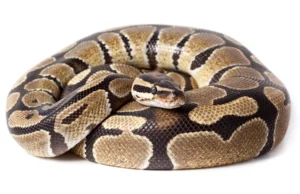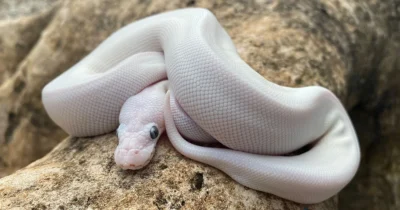Ever wondered, ‘How long can a ball python go without water?‘ Ensuring proper hydration is essential for the health of your ball python. Let’s explore the factors that influence their hydration needs and find out just how long they can go without water.
Ball pythons, like all animals, need water to survive. However, they are quite resilient and can go for a significant amount of time without water, though this shouldn’t be a regular occurrence.
Under normal conditions, a ball python should have access to clean water at all times. However, if for some reason a ball python is deprived of water, it can survive for about 2-4 weeks without water, depending on factors such as temperature and humidity.
Keep in mind that this is not a recommended practice, and it’s crucial to ensure that your ball python always has access to fresh water. Depriving them of water can cause stress, dehydration, and eventually lead to health issues.
Importance of water for ball pythons

Water is crucial for the health and well-being of ball pythons, as it is for all living creatures. Here are some reasons why water is important for ball pythons:
- Hydration: Just like any other animal, ball pythons need water to stay hydrated. Dehydration can lead to serious health issues and even death.
- Assisting with Shedding: Proper hydration helps ball pythons to shed their skin effectively. Insufficient hydration can result in difficult or incomplete sheds, which may lead to health problems such as retained eye caps or skin infections.
- Aiding Digestion: Adequate water intake is essential for proper digestion. Ball pythons need water to facilitate the digestion of their food.
- Regulating Body Temperature: Ball pythons often use their water bowls to help regulate their body temperature. They may soak in the water to cool down if they are too warm or to increase humidity levels if the environment is too dry.
- Preventing Respiratory Issues: Maintaining proper humidity levels in the enclosure is important for preventing respiratory problems. Water bowls help to increase humidity levels, which is vital for the respiratory health of ball pythons.
For these reasons, it’s essential to always provide your ball python with access to clean, fresh water.
How long can a ball python go without water?
Ball pythons, like all living creatures, require water to survive. While they are quite resilient, they can only go for a limited time without access to water before experiencing health issues.
Under normal circumstances, a ball python should have access to clean water at all times. However, if for some reason a ball python is deprived of water, it can survive for about 2-4 weeks without water, depending on various factors such as temperature, humidity, and the snake’s overall health.
During this time without water, the ball python’s body will start to dehydrate. Dehydration can lead to serious health problems, including organ failure and eventually death. The exact duration a ball python can survive without water varies from snake to snake and depends on factors such as its size, age, health, and environmental conditions.
It’s essential to always ensure that your ball python has access to clean, fresh water to prevent dehydration and keep it healthy. Depriving them of water for any length of time can cause stress, dehydration, and serious health issues.
Water Requirements for Ball Pythons
Water is essential for the health and well-being of ball pythons. Here’s why:
- Hydration: Like all animals, ball pythons need water to stay hydrated. Dehydration can lead to serious health issues and even death.
- Shedding: Adequate hydration is crucial for proper shedding. Insufficient hydration can lead to difficult or incomplete sheds, which may cause retained eye caps or skin infections.
- Digestion: Water is necessary for the digestion of food. Ball pythons need water to help break down and digest their meals effectively.
- Temperature Regulation: Ball pythons use water to regulate their body temperature. They may soak in their water bowls to cool down if they are too warm or to increase humidity levels if the environment is too dry.
- Respiratory Health: Maintaining proper humidity levels in the enclosure is important for preventing respiratory problems. Water bowls help to increase humidity levels, which is vital for the respiratory health of ball pythons.
Ensure that your ball python always has access to clean, fresh water in a shallow dish that is large enough for them to soak in if needed. Change the water regularly to prevent bacterial growth and always monitor your snake’s hydration levels to ensure they are healthy and well-hydrated.
Factors Affecting Water Requirements

Several factors can affect the water requirements of ball pythons:
- Temperature: Warmer temperatures can increase the rate of evaporation, leading to higher water requirements. Ball pythons may also seek out water more frequently to cool down if temperatures are too high.
- Humidity: Low humidity levels can increase the rate of evaporation, leading to faster dehydration. Ball pythons require adequate humidity to maintain hydration levels and respiratory health.
- Size and Age: Larger and older ball pythons may have higher water requirements than smaller or younger snakes. They may also be less able to tolerate dehydration.
- Activity Level: Active ball pythons may require more water than sedentary ones. Snakes that are more active or are undergoing breeding, digestion, or shedding may need increased hydration.
- Health Status: Sick or injured ball pythons may have altered water requirements. They may require more water to aid in recovery or to compensate for fluid loss.
- Diet: The type and size of prey can affect a ball python’s water requirements. Snakes that consume whole prey items may get some of their hydration from their food, while those fed on pre-killed or frozen-thawed prey may need to drink more water.
- Enclosure Conditions: The size of the enclosure, the type of substrate used, and the presence of hides and other furnishings can all affect humidity levels and water requirements.
It’s essential to monitor your ball python’s behavior and hydration levels regularly and adjust their water availability as needed based on these factors. Always ensure that your snake has access to clean, fresh water to prevent dehydration and maintain optimal health.
Managing Water Needs for Ball Pythons
Managing water needs for ball pythons is essential for their health and well-being. Here’s how you can ensure your ball python stays hydrated:
- Provide Clean Water: Always provide your ball python with access to clean, fresh water in a shallow dish that is large enough for them to soak in if needed. Change the water regularly to prevent bacterial growth and ensure it stays clean.
- Monitor Hydration Levels: Keep an eye on your ball python’s hydration levels by observing their behavior and the condition of their skin. A well-hydrated snake will have clear, smooth skin, while a dehydrated snake may have wrinkled or loose skin.
- Maintain Proper Humidity Levels: Ball pythons require adequate humidity levels to stay hydrated and maintain respiratory health. Ensure that the humidity levels in the enclosure are appropriate for your snake’s needs.
- Provide a Humid Hide: Include a humid hide in your ball python’s enclosure to help them regulate their hydration levels. A humid hide filled with damp sphagnum moss or paper towels can provide a moist environment for your snake to retreat to when needed.
- Offer Soaking Opportunities: Some ball pythons may enjoy soaking in their water dish, especially when they are about to shed or when temperatures are too high. Providing a large enough water dish for soaking can help your snake stay hydrated and cool.
- Adjust Water Availability: Consider environmental factors such as temperature, humidity, and activity level when managing your ball python’s water needs. During warmer weather or when your snake is more active, they may require more water.
- Regular Health Checks: Monitor your ball python’s overall health and behavior regularly. Signs of dehydration include lethargy, sunken eyes, wrinkled skin, and loss of appetite. If you notice any signs of dehydration, ensure that your snake has access to water and consider seeking veterinary care if necessary.
By following these guidelines and paying attention to your ball python’s behavior and hydration levels, you can help ensure that your snake stays healthy and hydrated.
Conclusion
This page answers the question on how long can a ball python go without water. While ball pythons are resilient animals, they can only go for a limited time without access to water. Under normal circumstances, a ball python should always have access to clean, fresh water.
However, if deprived of water, they can survive for about 2-4 weeks, depending on factors such as temperature, humidity, and the snake’s overall health. Nonetheless, depriving them of water for any length of time can lead to dehydration, stress, and serious health issues.

